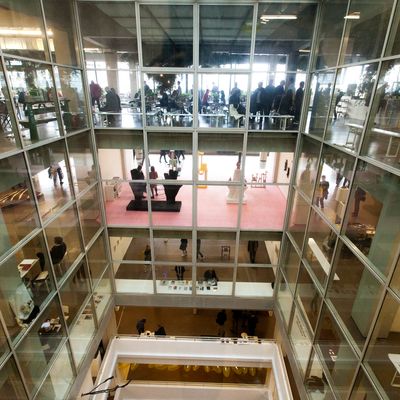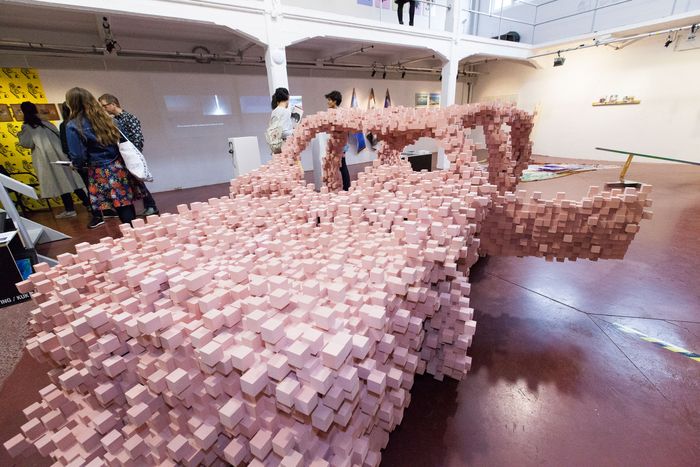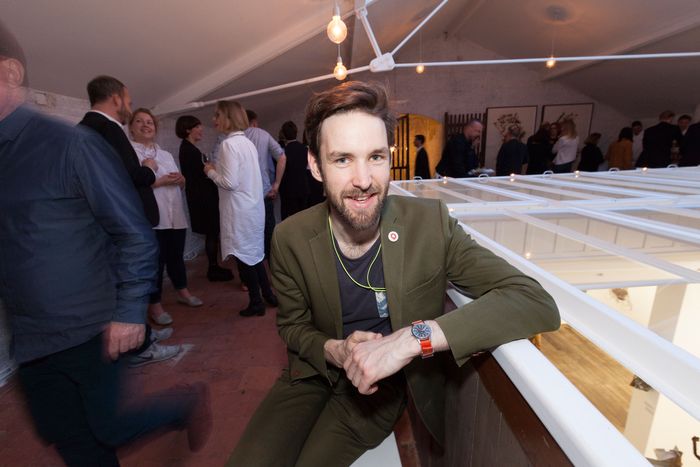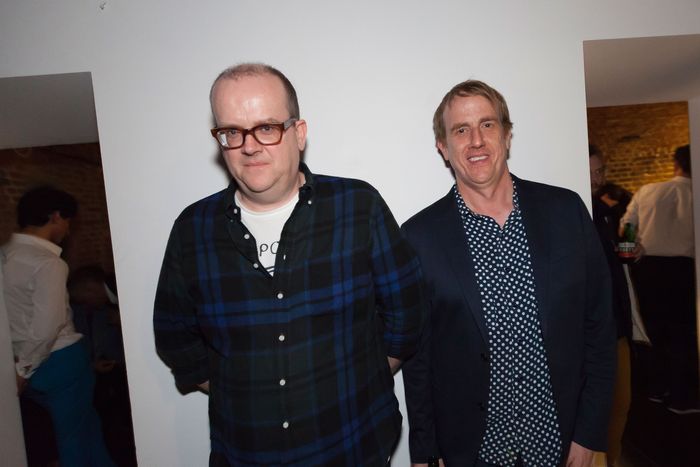On March 22, the day of the coordinated terrorist attacks in Brussels, plans were well underway for the cityÔÇÖs annual art-fair week┬áÔÇö one uneasy month away. This was the first year that the Independent chose the capital of the European Union (if not necessarily the European art world, which is divided between London, Paris, and Berlin, among other places) to expand into, adding its edgier offerings to those of the long-established Art Brussels fair, as it does in New York (where the Independent complements the Armory Show).
The ÔÇ£art worldÔÇØ draws from, in fact, the entire world: ItÔÇÖs international, borderless, cosmopolitan, and often gathers itself in great cities which we have seen have also been targets of terrorists (the November attacks in Paris happened to coincide with Paris Photo.) After it happened, local attendees and organizers I spoke with, said they had to do battle with perceptions from media coverage of the city, a need to defy the terroristsÔÇÖ motives of disrupting daily life. Independent co-director Olivier Pesret, who, when pressed about the attacksÔÇÖ impact on the timing of the fair, said, ÔÇ£The events were tough, but we immediately got on the phone with our 72 exhibitors and there were very few who felt uneasy. ItÔÇÖs not a war zone. The media was showing military in front of the courthouse ÔÇö but theyÔÇÖre there year round! No exhibitors backed out. Two days after the attacks we had a dinner and instead of 80, we had 110 people show up.ÔÇØ
A spirit of defiance was added to a spirit of seriousness about art which already existed. Brussels might not be the flashiest place in Europe, but there are other reasons for the art world to gather there. ÔÇ£Brussels was an obvious city for us,ÔÇØ said Pesret. ÔÇ£More or less 50 percent of our exhibitors come from Europe, and we wanted to be closer to home for them. At the same time we wanted to be able to attract our American audience to Europe outside of a city which they always know ÔÇö Paris, London, etc. So we chose a city where we could have a positive impact, and Brussels has changed radically in a very good way. A lot of artists do residencies at the art center Wiels and then they stay because itÔÇÖs inexpensive and central. In two hours youÔÇÖre in all the major capitals. And youÔÇÖre in a country that has been supporting the arts for centuries. ItÔÇÖs something that is really deeply ingrained in people here. The mentality goes alongside our core philosophy of supporting artists and galleries. In Brussels, itÔÇÖs very easygoing and at the same time thereÔÇÖs a high quality of art. The collectors are serious ÔÇö they really want to know more. ItÔÇÖs not an impulse buy.ÔÇØ
During my stay in Brussels, I visited the the Poppositions fair, known for exhibiting emerging artists and galleries, and I asked this yearÔÇÖs director, Nicolas de Ribou, to discuss the effect of the recent attacks on the fair week ÔÇö if any. He stated, ÔÇÿItÔÇÖs a bit different now than one month ago, but we were aware that something would happen. We knew since November,ÔÇØ he said referring to BelgiumÔÇÖs lockdown in a manhunt for Paris terrorist-attack organizer Salah Abdeslam. ÔÇ£ItÔÇÖs the strangest feeling but once it happens you feel more comfortable. You know it will happen again ÔÇö but not for a while. Belgian people are really not scared.ÔÇØ
Others, such as the Iranian-born Brussels-based artist Sanam Khatibi, generally attributed the attacks to a problem in the lack of successful population integration and felt that more security would have little effect. Khatibi asserted, ÔÇ£I think what happened could have happened anywhere. ItÔÇÖs unfortunate that, yes, we have certain areas in Brussels where it turned out the attack planners were from those communities. There has always been integration problems. But unfortunately itÔÇÖs a community that has difficulties integrating. And of course ÔÇö the main issue is petrol and money. Our politicians have been bombing and doing all sorts of things in [Islamic] regions and people have been suffering for years. We havenÔÇÖt been doing anything about it, so now theyÔÇÖre bringing it here. We get shocked about 135 people dying, but people are dying everyday. I had to leave my own country because of the same issues ÔÇö itÔÇÖs just different names and different people. Today, itÔÇÖs here, but tomorrow it will be somewhere else.ÔÇØ Khatibi lives a ten-minute walk from the bombed metro station, Maalbeek ÔÇö she heard military helicopters leading up to the attacks, which alerted her that an attack was imminent. ÔÇ£WeÔÇÖre all very sad, touched by it. But IÔÇÖm not going to lock myself up because it happened. I donÔÇÖt think the more military we put out the safer we are because if someone is willing to die to put off a bomb, it doesnÔÇÖt matter. I donÔÇÖt feel safer seeing 20 military guards.ÔÇØ
Brussels is in an unprecedented position. The cityÔÇÖs fair attendees have a well-proven track record for supporting often quite edgy art which coexists with the cityÔÇÖs complicated (and in some ways troubling)┬ápolitical history. Out of this, it is today a polyglot international city which provides an undeniably unique breeding ground for idea exchange because of its accepted coexistence of cultural diversity and lack of ethnic (or even linguistic) dominance. In this sense, New York, London, Paris eclipse one another, at least partially, whereas BrusselsÔÇÖs art identity remains undetermined ÔÇö allowing todayÔÇÖs multifaceted art worlds (not unlike BelgiumÔÇÖs many cultural populations) to potentially intermingle, freely, in uncharted territory outside of the direct influence of a major international metropolis. Art, in this light, would get its own city.
Below is a three-day photo diary of the artwork and conversations I encountered at the art fairs, local arts institutions, and artist studios.
I touch ground in Brussels Airport at 8 a.m. IÔÇÖm expecting to spot evidence of the bombings ÔÇö but they happened in the departure hall ÔÇö and to encounter loads of armed military keeping an eye out (there are a few at the taxi line). But in actuality I feel not much different than arriving in Newark or LaGuardia, except for the noticeable scarcity of travelers.
At the main fair ÔÇö Art Brussels (similar in size and emphasis to the Armory Show in New York) ÔÇö the handmade and tactile moments stand out.
Photo: Sarah Trigg/┬® Sarah Trigg
Photo: Sarah Trigg/┬® Sarah Trigg
Prague-based Kri┼ítof KinteraÔÇÖs spillage of light fixtures, in his solo presentation at D+T Project Gallery, Brussels.
Photo: Sarah Trigg/┬® Sarah Trigg
I meet with the fairÔÇÖs managing director, Anne Vierstraete, in front of an untitled Gert & Uwe Tobias work at the Brussels-based Rodolphe Janssen booth. She states, ÔÇ£At the entrance of the fair are the most experimental ÔÇö 30 galleries in the Discovery section. Then, the Prime section shows more established galleries. Compared to last year we had 34 newcomers even though we reduced the size overall by 50 galleries. We also added 24 solo shows. Then, the Rediscovery section shows works that have been underestimated ÔÇö that we think should be reconsidered. We are among the three oldest fairs in the world, along with Art Basel and Art Cologne ÔÇö itÔÇÖs a very vibrant art scene.ÔÇØ
Photo: Sarah Trigg/┬® Sarah Trigg
Vietnamese Dinh Q. L├¬ÔÇÖs ÔÇ£pouredÔÇØ c-prints TWC in Four Moments at Shoshana Wayne Gallery (Santa Monica).
Photo: Sarah Trigg/┬® Sarah Trigg
The playful and unexpected ceramics by Brussels-based Eric Croes at Rossi Contemporary (Brussels).
Photo: Sarah Trigg/┬® Sarah Trigg
I make a pitstop at the MIMA, Millennium Iconoclast Museum of Art, dedicated to street art and located in the region of Molenbeek (home of the Paris terrorist-attack planners). Pictured, Maya HayukÔÇÖs installation City Lights on the museumÔÇÖs second floor.
Photo: Sarah Trigg/┬® Sarah Trigg
In the museumÔÇÖs basement, I encounter the work of
Swoon┬áÔÇö the street artist brought into limelight in the ÔÇÿ00s by arts dealer/curator extraordinaire Jeffrey Deitch. The artist was invited to take over in the museumÔÇÖs raw cellar, and a scene of her pasted drawings appear at each turn, growing ÔÇö it seems ÔÇö on the columns, ceilings, and floor.
Photo: Sarah Trigg/┬® Sarah Trigg
Next, I visit Poppositions nearby. Young Emerging Artists Eating and Fucking, a video by the New York-based Israeli duo Tamy Ben-Tor and Miki Carmi catches my eye with a character I imagine as the offspring of
Jordan WolfsonÔÇÖs robot and a muse of Cindy Sherman.
Photo: Sarah Trigg/┬® Sarah Trigg
Pictured, Robert KunecÔÇÖs sculpture Explosus.
Photo: Sarah Trigg/┬® Sarah Trigg
In the evening, I head to the cityÔÇÖs center for a dinner hosted by Independent Brussels at its permanent gallery space Independent R├®gence, which will host exhibitions year-round and which is separate from the much larger fair space. Pictured, co-director of Independent Brussels Olivier Pesret.
Photo: Sarah Trigg/┬® Sarah Trigg
During the afterparty at Cinema Galeries, I encounter artist/curator Matthew Higgs (at left) ÔÇö founding creative advisor of the Independent fair in both New York and Brussels┬áÔÇö and Tyson Reeder (right), artist and fair organizer of wildly alternative fairs such as the
2009 Dark Fair in Cologne┬áÔÇö without any electricity.
Photo: Sarah Trigg/┬® Sarah Trigg
Left to right: Scott Indrisek, editor-in-chief of Modern Painters; the painter Steven Cox; and London-based art-writer-turned-gallerist Coline Milliard of Carroll/Fletcher gallery.
Photo: Sarah Trigg/┬® Sarah Trigg
Friday morning, I visit the studio of the Belgian artist Thomas Lerooy, who returned to his home country two years ago after living in Berlin for many years. He discusses with a visiting collector his sculpture The Beauty in the Shadow of the Stars which exhibited at Le Petit Palais in Paris. At the time, the museumÔÇÖs collection was in storage while the building was undergoing restoration ÔÇö which inspired him. ÔÇ£I thought: I want to make a piece thatÔÇÖs sleeping, resting, calm ÔÇö not worrying about the problems that are always there. Also this idea that IÔÇÖm restoring the piece with tape ÔÇö a material that is temporary. This piece is still falling apart like we canÔÇÖt help it somehow.ÔÇØ
Photo: Sarah Trigg/┬® Sarah Trigg
LerooyÔÇÖs Embrace in the foreground.
Photo: Sarah Trigg/┬® Sarah Trigg
Afterward, Rodolphe Janssen director Sybille du Roy invites me to the gallery where I re-encounter works by Eric Croes in the group show Made in Oven of ceramics along with some real gems by the Brooklyn-based artist Dan McCarthy (shown here), in a sea of foliage designed by Thierry Boutemy, a florist who frequently collaborates with artists.
Photo: Sarah Trigg/┬® Sarah Trigg
Next, I meet with Dirk Snauwaert, the director of the relatively new art center Wiels residing in a former beer brewery of the same name and partly modeled after New YorkÔÇÖs PS1 and New Museum. On view is the Belgian artist Edith DekyndtÔÇÖs retrospective Indigenous Shadow featuring many of her ÔÇ£livingÔÇØ sculptures such as a series of Ikea rugs embalmed with beer-brewing bacterial cultures ÔÇö and, pictured here, a ÔÇ£rugÔÇØ of dust that has been methodically collected from the museumÔÇÖs floor.
Photo: Sarah Trigg/┬® Sarah Trigg
The arrival of the New York-originated Independent art fair in Brussels this year, in the spacious Vanderborght building, sets the stage for the city to evolve as an art-market hub.
Photo: Sarah Trigg/┬® Sarah Trigg
At the entrance are the ever-poised works by New York-based artist Carol Bove at David Zwirner (New York and London) with her newer ones incorporating bright color.
Photo: Sarah Trigg/┬® Sarah Trigg
Wolfgang BetkeÔÇÖs StyliteÔÇÖs Dreams at Berlin-based gallery Aurel Scheibler (Berlin).
Photo: Sarah Trigg/┬® Sarah Trigg
CLEARING galleryÔÇÖs (New York and Brussels) booth of works by Poughkeepsie-based Huma Bhabha.
Photo: Sarah Trigg/┬® Sarah Trigg
Le Salon (Brussels), invited by Almine Rech Gallery (Paris, Brussels, London), organizes a cat-scratching headquarters including works by John M Armleder, Laurent le Deunff, Regina Maria M├Âller, and Amanda Ross-Ho.
Photo: Sarah Trigg/┬® Sarah Trigg
Rachel de JoodeÔÇÖs wormhole-like works successfully combine the photographic with sculpture at Galerie Christophe Gaillard (Paris).
Photo: Sarah Trigg/┬® Sarah Trigg
In the evening, per Jerry SaltzÔÇÖs advice, I hightail it up to the Het Noordbrabants Museum for a chance of a lifetime to see Hieronymus Bosch: Visions of Genius in the master painterÔÇÖs hometown, ÔÇÿs-Hertogenbosch ÔÇö marking the 500th anniversary of the artistÔÇÖs death. Nine years in the making, the exhibition hosts the largest and most unprecedented survey of Bosch works to date. Pictured, The Haywain Triptych, 1510-16.
Photo: EVERT ELZINGA/┬® Sarah Trigg
During the art fair week, the museum is open until 1 a.m. to accommodate as many timed tickets of visitors as possible before the exhibition heads to the MadridÔÇÖs Prado museum where the works will reunite with the masterpiece The Garden of Earthly Delights. Pictured here, Saint John the Baptist, c. 1490-95.
Photo: Mike Bink/┬® Sarah Trigg
Saturday morning, I visit the home studio of Iranian-born Sanam Khatibi, a painter who incorporates tapestries, embroidery, and clay works, into her oeuvre. Khatibi details the narrative of a painting in progress at left, ÔÇ£The male figures are coming back from a hunt. The female figure is waiting to greet them holding the head of the male figure behind her. ThereÔÇÖs often an absence of the men in my paintings. We donÔÇÖt know if itÔÇÖs due to the animals or if there are no men any longer. ItÔÇÖs usually the women amongst themselves getting into all sorts of mischief. You donÔÇÖt know if they are enjoying it or going through pain.ÔÇØ
Photo: Sarah Trigg/┬® Sarah Trigg
Khatibi states, ÔÇ£IÔÇÖm a collector of things. The objects become sacralized and are part of my work. The theme IÔÇÖm working on right now involves animality, loss of control, power games, dominance, sexuality, primitive instincts. ThereÔÇÖs a lot of humor too. I love playing with titles.ÔÇØ Pictured at right is KhatibiÔÇÖs ÔÇ£Whenever I dance for you I get into troubleÔÇØ based on the 16th-century Flemish tapestry ÔÇ£The Return of the HuntÔÇØ ÔÇö except that she replaced the male figures with female ones who have set the castle in the horizon ablaze. Other titles are: ÔÇ£My Garden is Wilder Than YoursÔÇØ; ÔÇ£IÔÇÖm Running Away With Your WifeÔÇØ; and ÔÇ£To Save Her I Would Murder the World.ÔÇØ
Photo: Sarah Trigg/┬® Sarah Trigg
I finish up with a visit to La Loge, an alternative exhibition space for emerging art housed in a former Masonic temple, to see the group show Pastoral Myths. Pictured here are the works of the Ukrainian artist Olga Balema of found agricultural feeding troughs she painted with the brand colors of agricultural manufacturer John Deere.
Photo: Lola PERTSOWSKY
At left, a painting by Amelie von Wulffen; right, a looped eight-second film by Daniel Dewar & Gr├®gory Gicquel.
Photo: Lola PERTSOWSKY
The cityÔÇÖs center at dusk.
Photo: Sarah Trigg/┬® Sarah Trigg
































